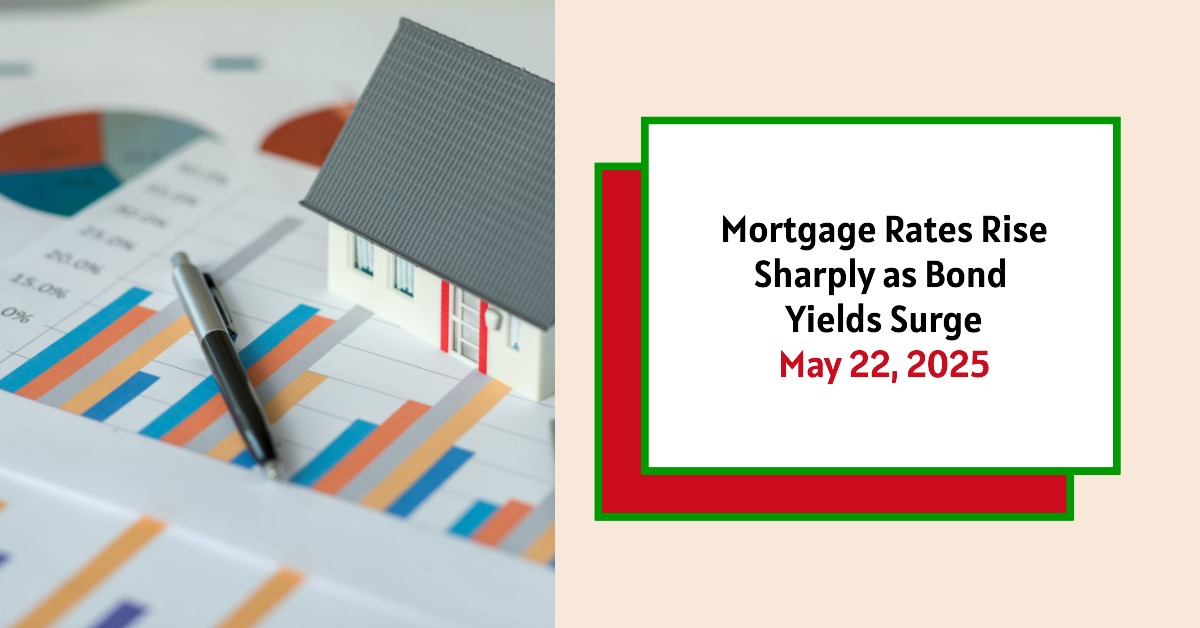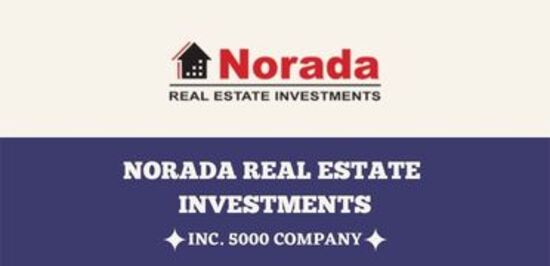On May 22, 2025, mortgage rates are sharply higher as concerns over national debt impact the bond market. The average 30-year fixed mortgage rate is now 6.93%, while 15-year fixed mortgages remain at 6.08%. For potential homebuyers and those considering refinancing, it's crucial to stay updated on these rates, as they heavily influence your mortgage payments and overall financial planning.
Today's Mortgage & Refinance Rates – May 22, 2025: Rates Rise Sharply Across the Board
Key Takeaways
- Mortgage Rates: Average 30-year fixed is 6.93%, up 13 basis points.
- Refinance Rates: Average 30-year fixed refinance is 7.04%.
- Short-Term Stability: 15-year fixed rates remain steady at 6.08%.
- Debt Concerns: National debt concerns are affecting bond yields and influencing higher mortgage rates.
- Adjustable Rates: 5/1 and 7/1 ARMs are currently at 7.58% and 7.54%, respectively.
Today's Mortgage Rates: A Comprehensive Overview
The mortgage market is continually shifting, and today marks a significant uptick in interest rates. Let’s break down the current numbers based on the most recent data from Zillow, providing insights into how different types of mortgages are faring against each other under today's economic conditions.
Current Mortgage Rates
| Type | Rate |
|---|---|
| 30-year fixed | 6.93% |
| 20-year fixed | 6.59% |
| 15-year fixed | 6.08% |
| 5/1 ARM | 7.58% |
| 7/1 ARM | 7.54% |
| 30-year VA | 6.42% |
| 15-year VA | 5.87% |
| 5/1 VA | 6.48% |
As the table illustrates, the 30-year fixed mortgage has gained 13 basis points today, reflecting the broader economic sentiments tied to the national deficit. For those looking into shorter-term commitments, the 15-year fixed mortgage remains an attractive option at 6.08%, allowing homeowners to build equity faster while still benefiting from lower long-term interest costs.
Current Mortgage Refinance Rates
For homeowners considering refinancing, here are today's average refinance rates:
| Type | Rate |
|---|---|
| 30-year fixed | 7.04% |
| 20-year fixed | 6.86% |
| 15-year fixed | 6.14% |
| 5/1 ARM | 7.93% |
| 7/1 ARM | 7.40% |
| 30-year VA | 6.46% |
| 15-year VA | 6.15% |
| 5/1 VA | 6.50% |
Comparing these rates to those for new purchases, you’ll notice that refinance rates can be slightly higher. This difference often arises from closing costs associated with refinancing, which can vary significantly among lenders. Homeowners must weigh these considerations when deciding whether to refinance their mortgage, keeping in mind how current interest rates impact the overall financial landscape.
Factors Influencing Mortgage Rates
Understanding what drives mortgage rates is essential for potential borrowers. Let’s delve deeper into the factors influencing these fluctuations:
- Economic Environment: The mortgage market is inherently linked to economic conditions. Currently, rising concerns about national debt are adversely impacting bond market performance. A pivotal indicator, the 10-year Treasury yield, recently surpassed 4.5%, signifying increased borrowing costs for homes. When investors perceive uncertainty in government fiscal policies, they often demand higher yields on bonds, thus driving up mortgage rates.
- Inflation and Employment Rates: The relationship between inflation, employment rates, and mortgage rates is intricate. Typically, when the economy is robust, mortgage rates rise to temper spending and borrowing. Conversely, during periods of economic weakness, when unemployment is high, rates may decline to stimulate borrowing. Understanding this cyclical nature can empower buyers to time their entries into the housing market effectively.
- Creditworthiness: A potential borrower’s financial profile has a direct effect on the interest rates offered. Lenders assess credit scores, debt-to-income ratios, and down payments when determining rates. Higher credit scores generally yield lower rates. If a borrower can settle outstanding debts or save for a larger down payment before applying for a mortgage, they are positioned to secure a more favorable interest rate.
- Federal Reserve Policies: The Federal Reserve plays a crucial role in determining the broader economic landscape. When the Fed adjusts its benchmark interest rates, it influences mortgage rates indirectly. If the Fed raises rates to combat inflation, it often results in an uptick in mortgage rates. Conversely, lowering rates can help to stimulate economic activity by making borrowing cheaper.
Understanding Different Types of Mortgages
As potential borrowers navigate the changing rates, it’s vital to comprehend the various mortgage types available:
- Fixed-rate Mortgages: These loans secure an interest rate for the complete loan term, providing borrowers with certainty. For instance, a 30-year fixed mortgage at 6.93% means this interest rate will hold firm throughout the loan duration, offering predictable monthly payments.
- Adjustable-rate Mortgages (ARMs): Unlike fixed rates, ARMs have interest rates that can fluctuate based on market conditions after an initial fixed period. For example, a 5/1 ARM offers a fixed rate for the first five years, followed by annual adjustments. While these might initially present lower rates, they carry risks if market rates rise significantly, making them less predictable in long-term financial planning.
Impact of Rates on Monthly Payments and Total Costs
When assessing the total costs of a mortgage, one must understand how interest rates directly influence monthly payments. Here’s how various rates affect potential expenditures:
Using the average 30-year fixed rate of 6.93% for a hypothetical mortgage of $300,000:
- Principal and Interest Payment:
- Using a mortgage calculator, a $300,000 loan at 6.93% yields a monthly payment of approximately $1,995.85 for principal and interest.
- Refinancing Example with a 30-year fixed at 7.04%:
- Should a homeowner refinance at a 7.04% rate, their monthly payment would rise slightly to about $2,008.19. This illustrates how the incremental rise in rate translates into considerable dollar amounts over time.
- Impact Over the Loan Term:
- Over 30 years, a borrower paying 6.93% will pay roughly $719,000 in total payments (principal + interest). If refinancing at 7.04%, the total payment could ascend to approximately $723,000. This highlights how a seemingly small difference in interest rates can accumulate significant costs over the life of a loan.
Read More:
Mortgage Rates Trends as of May 21, 2025
Dave Ramsey Predicts Mortgage Rates Will Probably Drop Soon in 2025
Future of Mortgage Rates Post-Fed Decision: Will Rates Drop?
Fed's Decision Signals Mortgage Rates Won't Go Down Significantly
Current Market Sentiments and Expectations
As of May 22, 2025, the general sentiment in the mortgage market is one of caution and uncertainty. There is a prevailing belief that both existing homeowners and potential buyers are grappling with the pressures posed by rising rates. The phenomenon known as the “rate lock-in effect,” where homeowners are hesitant to sell due to the loss of their low-rate mortgage, has constricted inventory in many markets.
Moreover, market participants are bracing for continued fluctuations. Reports indicate that even as fears linger concerning debt and inflation, some experts believe home sales might increase as buyers who have postponed purchases come back into the market. The expectation is that home sales could recover relative to last year, albeit still below historical averages, as buyers adjust to the new normal of elevated rates.
Future Projections for Mortgage Rates
Looking ahead, mortgage rate forecasts from reputable sources such as Fannie Mae and the Mortgage Bankers Association (MBA) provide a glimpse of potential movements through 2026:
| Forecaster | Q2/25 | Q3/25 | Q4/25 | Q1/26 |
|---|---|---|---|---|
| Fannie Mae | 6.5% | 6.3% | 6.2% | 6.1% |
| MBA | 7.0% | 6.8% | 6.7% | 6.6% |
These projections show an anticipated gradual decline in rates over the next few quarters, although they remain higher than many market participants would prefer. The ongoing economic conditions — particularly regarding employment and inflation — will heavily influence whether these forecasts materialize or adjust in the face of new data and economic indicators.
Conclusion
In summary, the current mortgage environment on May 22, 2025, is marked by higher rates influenced by national debt concerns and market volatility. Both potential homebuyers and those considering refinancing must navigate this landscape carefully, considering the impact of various mortgage types and the long-term costs associated with higher interest rates. As economic conditions evolve, so too will mortgage rates, making it essential to stay informed and engaged with credible financial news sources and expert analyses.
Invest Smarter in a High-Rate Environment
With mortgage rates remaining elevated this year, it's more important than ever to focus on cash-flowing investment properties in strong rental markets.
Norada helps investors like you identify turnkey real estate deals that deliver predictable returns—even when borrowing costs are high.
HOT NEW LISTINGS JUST ADDED!
Connect with a Norada investment counselor today (No Obligation):
(800) 611-3060
Also Read:
- Will Mortgage Rates Go Down in 2025: Morgan Stanley's Forecast
- Expect High Mortgage Rates Until 2026: Fannie Mae's 2-Year Forecast
- Mortgage Rate Predictions 2025 from 4 Leading Housing Experts
- Mortgage Rates Forecast for the Next 3 Years: 2025 to 2027
- 30-Year Mortgage Rate Forecast for the Next 5 Years
- 15-Year Mortgage Rate Forecast for the Next 5 Years
- Why Are Mortgage Rates Going Up in 2025: Will Rates Drop?
- Why Are Mortgage Rates So High and Predictions for 2025
- Will Mortgage Rates Ever Be 3% Again in the Future?
- Mortgage Rates Predictions for Next 2 Years
- Mortgage Rate Predictions for Next 5 Years
- Mortgage Rate Predictions: Why 2% and 3% Rates are Out of Reach
- How Lower Mortgage Rates Can Save You Thousands?
- How to Get a Low Mortgage Interest Rate?
- Will Mortgage Rates Ever Be 4% Again?



